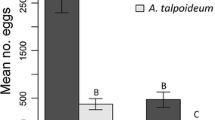Summary
A mark-recapture study was carried out in sympatric populations of Lacerta agilis and Lacerta vivipara in the Netherlands from 1976 to 1982. In most years the age structure of both populations was pyramidal. For both species life expectation of females was higher and on average they did live longer. Hence the sex ratio for adults deviated significantly from 1.0 in favour of females. Maximum age for Lacerta vivipara was 8 years (female) and for Lacerta agilis 12 years (male). The density of both species fluctuated around 100/ha. The biomass of Lacerta agilis was twice that of Lacerta vivipara. In Lacerta vivipara the 3rd and 4th calendar year class supplied 78% of total net reproduction; in Lacerta agilis the 4th, 5th, and 6th calendar year classes supplied 68%. In both populations the population replacement rate was 2. Population turnover time was 4.83 years for Lacerta agilis and 2.81 for Lacerta vivipara. The life history strategy of the Lacerta vivipara population is compared with six other European Lacertavivipara populations.
Similar content being viewed by others
References
Avery RA (1975a) Age-structure and longevity of common lizard (Lacerta vivipara) populations. J Zool (London), 176:555–558
Avery RA (1975b) Clutch-size and reproductive effort in the lizard Lacerta vivipara Jacquin. Oecologia (Berlin) 19:165–170
Ballinger RE (1973) Comparative demography of two viviparous iguanid lizards (Sceloporus jarrovi and Sceloporus poinsetti). Ecology 54:269–281
Ballinger RE (1979) Intraspecific variation in demography and life history of the lizard, Sceloporus jarrovi, along a altitudinal gradient in Southeastern Arizona. Ecology 60:901–909
Ballinger RE, Congdon JD (1981) Population ecology and life history strategy of a montane lizard (Sceloporus scalaris) in Southeastern Arizona. J Nat Hist 15:213–222
Bauwens D (1981) Survivorship during hipernation in the European common lizard, Lacerta vivipara. Copeia 3:741–744
Bauwens D (1985) Demografische karakteristieken en aantalsdynamiek in een populatie van de levendbarende hagedis (Lacerta vivipara). Thesis, Antwerpen
Bauwens D, Verheyen RF (1980) Anatalsfluctuaties en demografische karakteristieken van een populatie van de levendbarende hagedis (Lacerta vivipara). Research Report 11, Veldbiologisch Station kalmthout, Universitaire Instelling Antwerpen
Broers JLV, Clerx PMJ (1981) Oecologisch onderzoek aan Lacerta vivipara in het Oostenrijkse hooggebergte. Ph.D. thesis (204), Nijmegen
Clerx PMJ, Broers JLV (1982) Oecologisch onderzoek aan Lacerta vivipara, de levendbarende hagedis, in het Oostenrijks hooggebergte. Lacerta 41:77–92
Dunham AE (1982) Demographic and life history variation among populations of the Iguanid lizard Urosaurus ornatus: implications for the study of life history phenomena in lizards. Herpetologica 38:208–221
Heulin B (1984) Contribution à l'étude de la biologie des populations de Lacerta vivipara: stratégie démographique et utilisation de l'espace dans une population du massif forestier de Paimpont. Thesis, Rennes
Heulin B (1985a) Démographie d'une population de Lacerta vivipara de basse altitude. Acta Oecologica Oecol Gen 1985, 6:261–280
Heulin B (1985b) Maturité sexuelle et age à la premiére reproduction dans une population de plaine de Lacerta vivipara Can J Zool 63:1773–1777
Lenders HJR (1985) De oecologie van Lacerta vivipara in de Overasseltse & Hatertse Vennen: demografische karakteristieken. Ph.D. thesis (245), Nijmegen
Middelburg K (1986) De oecologie van Lacerta vivipara in de Overasseltse & Hatertse Vennen: populatie-en autoecologische aspecten. Ph.D. thesis (260), Nijmegen
Olsson M (1984) Spacing patterns and social systems in the sandlizard, Lacerta agilis (L.). Thesis, Göteborg
Patterson JW (1983) Frequency of reproduction, clutch size and clutch energy in the lizard Anguis fragilis. Amphibia-Reptilia 4:195–203
Pilorge T (1981) Structure et dynamique d'une population du lézard vivipare. Signification adaptive de la viviparité chez les lézards. Bull Soc Herp Fr 18:29–31
Pilorge T (1982) Stratégie adaptive d'une population de montagne de Lacerta vivipara. Oikos 39:306–312
Pilorge T, Xavier F (1981) Le lézard vivipare (Lacerta vivipara J.) dans la région du Puy-de-Dome: Ecologie et Stratégie de reproduction. Ann St Biol Besse Chandesse 15:32–59
Scepotev N (1948) «A population study of the sand lizard Lacerta agilis exigua EICHW. under the conditions of the forest steppe along the lower reaches of the Volga». (in Russian). Zool Zh 27:363–370
Schoener TW, Schoener A (1980) Densities, sex ratios and population structure in four species of Bahamian Anolis lizards. J Anim Ecol 49:19–53
Strijbosch H (1986) Niche segregation in sympatric Lacerta agilis and Lacerta vivipara. In: Rocek Z (ed) Studies in herpetology. Prague Charles University, pp 449–454
Tertyshnikov MF (1978) Reproduction of the sand lizard Lacerta agilis and Eremias arguta in Cis-Caucasia. Ekologiya 2:94–96
Tinkle DW (1967) The life and demography of the side-blotched lizard Uta stansburiana. Misc Publ Mus Zool Univ Mich 132:1–182
Tinkle DW (1967) The concept of reproductive effort and its relation to the evolution of life history of lizards. Am Nat 103:501–516
Tinkle DW (1972) The dynamics of a Utah population of Sceloporus undulatus. Herpetologica 28:351–359
Tinkle DW (1973) A population analysis of the sage-brush lizard Sceloporus graciosus in Southern Utah. Copeia 2:284–295
Tinkle DW, Ballinger RE (1972) Sceloporus undulatus: A study of the intraspecific comparative demography of a lizard. Ecology 53:570–584
Author information
Authors and Affiliations
Rights and permissions
About this article
Cite this article
Strijbosch, H., Creemers, R.C.M. Comparative demography of sympatric populations of Lacerta vivipara and Lacerta agilis . Oecologia 76, 20–26 (1988). https://doi.org/10.1007/BF00379595
Received:
Issue Date:
DOI: https://doi.org/10.1007/BF00379595




